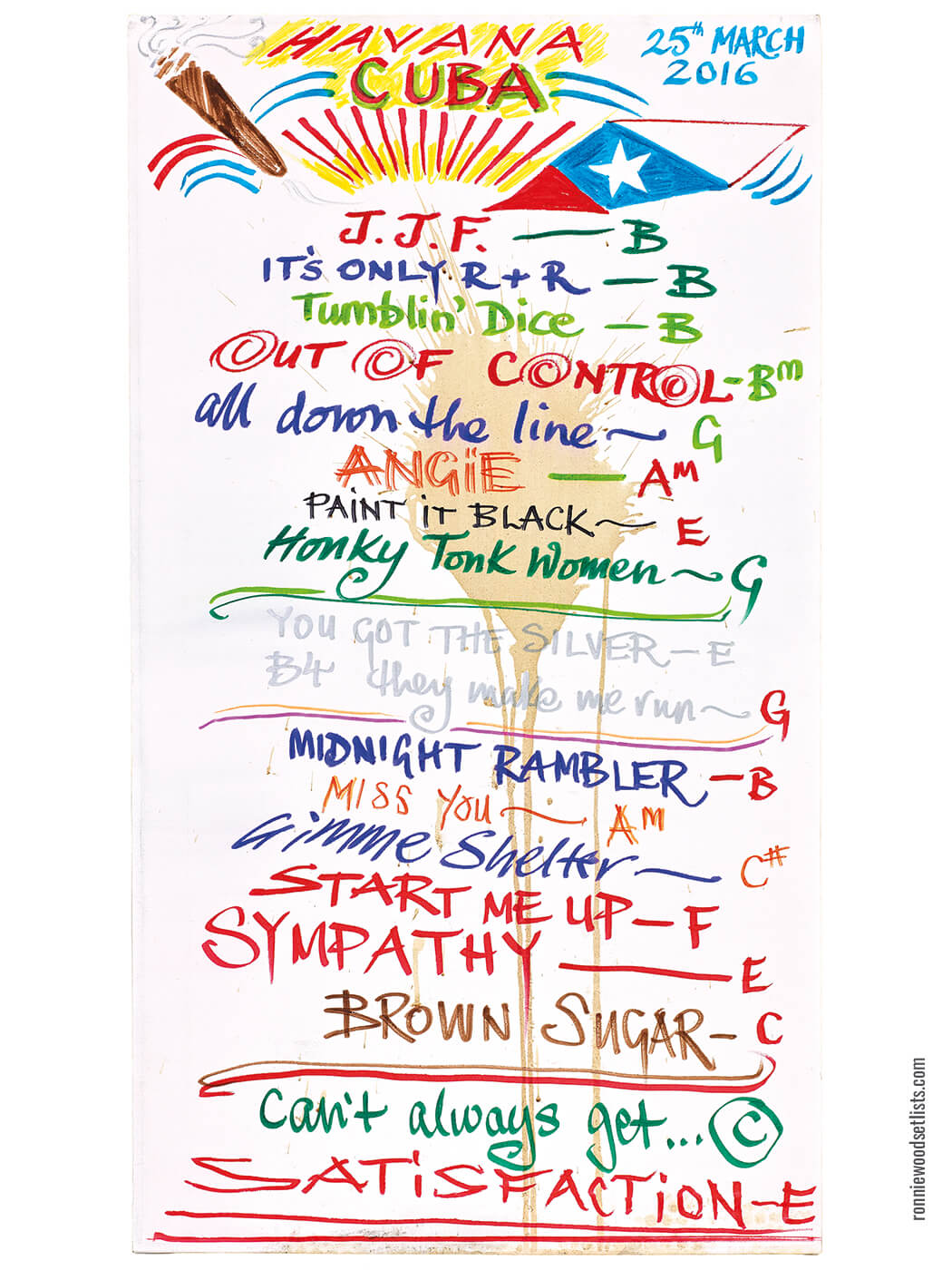Interview: Ronnie Wood, the rock ’n’ roll artist
He’s been the connective tissue for the world’s biggest band for over 40 years, but Ronnie Wood has more than just six strings to his bow. A lavish new book, The Rolling Stones Set Lists, shows off his artistic flair, while sobriety and his young family have renewed his lust for life…

Image: Getty Images
Ron Wood has experienced a rebirth. Not in a religious or New Age-y sense – but at the age of 71, he’s beaten cancer and attained hard-won sobriety after decades of overindulgence. Re-energised and refocused, he has a young family, a renewed sense of purpose and he’s finally recognising what truly matters to him.
Not content simply with playing guitar in the world’s greatest rock ’n’ roll band for over 40 years, the Rolling Stones guitarist has also maintained a parallel career as a respected painter. He’s speaking now because of his latest project: a sumptuous new book called The Rolling Stones Set Lists, which offers rare behind-the-scenes insights into the creative process of the Stones.
Wood was born in 1947 into a self-described “water gypsy” family, and lived on a canal boat in London with his two older brothers. They not only turned him on to music, but also painters – Caravaggio, Rembrandt, Goya, the Impressionists and others – and he started drawing. As a young teen, he picked up a guitar and instantly became captivated by the inherent possibilities and challenges. He was soon playing well enough to join local bands. At 17, Wood and friends formed R&B outfit The Birds, in London. In ’67, he moved onto The Jeff Beck Group, soon switching to bass for two landmark albums (Truth and Beck-Ola). After these, he joined the Faces along with ex-Jeff Beck Group singer Rod Stewart and returned to guitar.

He’s famously woven together a repertoire of guitar techniques that make him the ideal sideman and six-string foil (he’s also a master of both slide and pedal-steel playing), yet Wood’s foremost guitar signature is his visceral feel. He’s also effortlessly turned his hand to songwriting, with his fingerprints on rock classics such as Gasoline Alley, Ooh La La and Stay With Me; delivered solo albums (including I’ve Got My Own Album To Do, Gimme Some Neck), and collaborated with Bob Dylan, Aretha Franklin and David Bowie.
Wood became a Stone in the mid 70s, following Mick Taylor’s departure, and instantly became Keith Richards’ musical and spiritual sibling. They ignite the world’s stages to this day, helping to maintain the band’s reputation as an untouchable live act – a fact reinforced by their recent triumphant world tour.

Despite his jet-set lifestyle, Wood has continued painting over the years, with his portrait work collated in 2017’s Artist. The new book, the enormous, colourful limited-edition tome The Rolling Stones Set Lists, features more than 100 vividly handpainted setlists. These are interspersed with road anecdotes, to present a privileged view of the band at work.
Every picture tells a story
In the flesh, Wood is gregarious and looks far fitter than anyone who’s lived so hedonistically probably deserves to. Although we cover much ground, we begin by discussing the book, which is imbued with Wood’s innate playfulness. “The …Set List originals are big canvasses. Just one-offs. Pierre [de Beauport] my roadie, suggested I put these on canvasses. Then my publisher who did my Artist book, encouraged me to put them in a book. So here we are.”

With the Stones touring over the last 18 months, we ask, was it challenging to find the time to put the book together? “The hard part, for me, was choosing which ones were going to be used. It was a pleasure to put them together. The ones that were both easiest on the eyes and had the most to say on the show day are the ones we included,” Wood explains. “We have the boys joining in. Keith scribbled his little man here and there, plus instructions as to when to come in on a song. So it’s really a peek into our rehearsals and shows.”
Is there one gig included in The Rolling Stones Set Lists that especially resonates with him? “That’d be Cuba, because the fans enjoyed the gig so much and for many years, weren’t allowed to have Western musicians there. That is a high point. The way the audience was buzzing, we could feel their gratitude. The music was almost secondary to their emotions, which were so strong. Just the fact that we’d gone to them was almost too much for them. I guess it was a bit like playing Moscow, as we did back in the day. There’s a real give-and-take thing with the fans at times that is unforgettable. The passion is real.”
Visual art has been Wood’s own particular passion, and it’s one that extends right back to his childhood, when he first showed a talent for it. “As a young kid, when my mum would come to my school, they’d say to her: ‘You’re the mother of the artist,’ as I was known for art. Before I reached my teens, some of my drawings were featured on Sketch Club on the BBC, with one winning a prize – which only furthered my interest in art. But I’ve been painting even longer than playing guitar, so they go hand-in-hand for me. Colour fills my life. Even the decoration in my homes is a riot of colour. Ultimately, art fills my life, art is my life – and will continue to be.”

Because he has so much demand on his time professionally and personally, Wood has kept art studios in various locations to paint in solitude, including one in Barcelona. “I’ve also got one on the edge of Ashtead Forest. Right outside the studio, you walk out into the forest and see deer;plus, it’s silent, peaceful. In there, I’m painting landscapes most of the time.”
His evolution as a painter is ongoing. “I’ve done landscapes on and off, but now more intensely. I started doing abstracts as a kid, then moved into realism. But I’m returning to landscapes more as I’ve got older. Now I’ve got guitars growing out of the landscapes, so I call them ‘guitarscapes’,” he explains, showing off some of his wild creations.
Risky business
Ah yes, guitars. How does he keep the Stones’ songs fresh live after playing many of them for decades? “We change it all up. Every song gets run through its paces and it’s never the same twice. It’s always brand new and fresh because we know the songs, but not too well, where they become routine or too polished – which is great. And that’s where the element of risk is: our whole show can fall apart at any time and we love that feeling.”

What effect did switching between guitar and bass and back have on his playing? “Switching back and forth, they actually fed into each other. And that period I spent on bass with Jeff brought me a new perspective with guitar. It provided me with a more melodic playing than if I hadn’t been in that band. After I returned to the guitar, I went for the slide thing a lot more too, because of Duane Allman, who was such a huge influence on me.”
Being the only guitarist in the Faces forced him to play both lead and rhythm, which “helped prepare me for the dynamics with the Stones”. His playing, now so tightly interwoven with that of Keith Richards, makes them at times indistinguishable from each other… their synchronicity is sacred. “It’s an organic process of give and take with us two. If we make fans happy, then we’re happy.”
Are they still close friends, we ask? “Yeah, despite that we live in different countries [Richards has long resided in the USA]. We are godparents to each other’s kids and our grown-up children are close. It’s like a big family when we’re together on the road, because everyone comes out to join us.”

It’s the stuff of Stones folklore that Charlie Watts listens to Keith as the human metronome of the band. But who does Wood listen to? “I’m listening to Charlie, but I’m also conscious to play behind the beat, and I’m hearing the general feel of the song, the vocals, too. But I balance between guitar and bass, as I must hit a balance between the other four.”
Since his and Keith’s parts are so rhythmically interwoven throughout a Stones set, when it comes to playing lead guitar, does he enjoy stepping into the spotlight? “When I’m on a roll, I prefer to do my lead licks, yeah, definitely,” Wood smiles. “I do enjoy playing my Chuck Berry-style roots and the Eddie Taylor bluesy stuff. I still listen to Big Bill Broonzy, Elmore James, Hop Wilson, Grant Green, Matt Murphy, Hubert Sumlin… their styles have influenced me, resulting in my own style.”
Band of brothers
Wood owns an enviable guitar arsenal of vintage collectibles, but doesn’t take priceless gear out on the road. Naturally, he does have dozens of guitars at his disposal every night. “If we do 23 songs, as we did on the latest tour, I play 23 different guitars and every song is in a different tuning, too.”
After decades of touring, does Wood still experience jitters as he prepares to play to huge crowds in stadiums? “I do, but those are actually a nice feeling. It feels like you have to step up to the plate, it’s excitement and it makes life worth living.”

And after all the time that’s gone by, does he still socialise with the Stones? “We do get together occasionally when we’re not working, but the magic is to keep it sparse between us. I’m so lucky to have my art as my other self expression, to be able to put my creativity on a canvas when we’re not making music. No day is the same. Tomorrow, I’m doing a flamenco documentary. I’ll be painting a canvas of Paco Peña performing, taken from sketches I did at his last live show in London recently.”
Wood is also thankful that his art offers him creative freedom outside of music. “I will say I’m very fortunate to be painting, because there is so much downtime with the Stones when we’re not working. So painting, for me, is still a serious creative outlet. With guitar, I’m known as a slide player and rock guitarist, which is a defined genre. My art allows me to explore more. I break the confines of a chord sequence with my art. I’m able to do what I want, without having to think about being part of a band. No restrictions. For me, art and music are so similar that they bounce off one another, making me the person who I am.”
The Rolling Stones Set Lists by Ronnie Wood, the limited-edition book, is available from Genesis Publications. Buy it from at ronniewoodsetlists.com.
